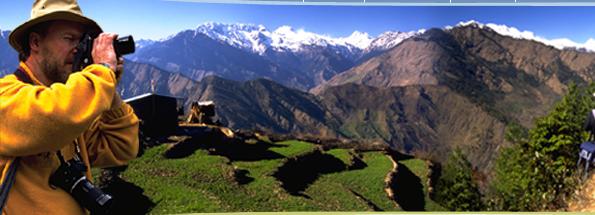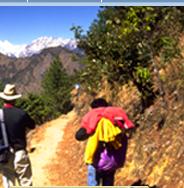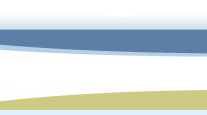
|
Different
Styles of Rafting trip |
|
|
Like trekking agencies,
commercial operators offer many difference
style of rafting trip to suit difference
people's idea of a holiday.
Most rafting trips in Nepal are group
participatory experiences where everyone
paddles the rafts, and pitches in to set
up camp and to some extent help cook the
meals, and to some extent help cook the
means. Most people enjoy participating
in the running of their expedition, sharing
and learning new outdoor skills.
However, you don't to super active –
if you want it, you can buy a quite luxurious
raft trip where you are rowed down the
river and a full team of staff does everything
for you; your tent is put up, you are
served drinks as you sit in a camp chair
and eat delicious meals off a white tablecloth.
Because labour is cheap in Nepal, a 'luxury'
safari – style trip like this is
not expensive and represents incredible
value when compared with other parts of
the world.
There are many various on these tow extremes,
and it is a matter of personal philosophies
and life style which you will prefer.
How Long?
Undoubtedly the best value
trips in both terms of the overall experience
and value for money are the long multi-
day trips such as the Sun Kosi, or Karnali.
Rafting trips like these, where you are
a way from the highway and 'civilization'
for a week or two are immensely uplifting
& memorable holidays of a lifetime-talk
to anyone who has been on one & they
will enthuse for hours & convince
you that if you can possibly afford it,
you should to book on one of these "world
classics".
If your time is limited, then you won't
get anything like this "world class"
experience on a 3 or 4 day trip-however
you will still get most of the rich escapist
thrills of a river trips,
You will get the same away-from- it-all
feeling, watching the sunrise on a quiet
misty beach, the adrenalin buzz of running
a big rapid, you will start to become
a proficient rafter & will settle
into the pleasant routine of camping on
the riverside. You will have time to slow
down to the pace of the river & to
enjoy the natural surroundings. It will
also, importantly, give you time to relax
& to get to know your guides &
fellow rafters.
Vacation time is limited, & for many
people these trips do represent a reasonable
compromise of time versus holiday experience.
A one or two day trip should be regarded
more as a" taster" where you
will only get a partial flavors of the
full rafting experience.
Mike Sunderland's makes the point that
a 3 day; 2-night raft trip doesn't mean
3 days of rafting. It may really be a
drive to the river on day one, & an
hour of rafting after lunch, 4 hours of
rafting on day two, then an hour on the
river on the last day prior to a long
drive home. This may or may not suit you,
but you can see why longer trips are better
value & experience.
Who enjoys Rafting?
Women in particular in our
experience- for many different reasons,
so don't ask us-ask them!
A rafting trip can be a wonderful family
holiday & an excellent experience
for older children but this obviously
depends on your family and how confident
they are about water. Most rafting companies
rivers such as the Sun Kosi. 7-13 year
olds would usually be happier and safer
on class 2-3 rivers. Points to note are
that camping because are relatively clean,
safe and friendly places. Children like
to be active and involved so a paddle-rafting
trip is better for older kids. An oar
rig, and a quieter river like the upper
Sun Kosi or the Seti would be better for
younger children.
There is no upper age limit for rafting;
the nice thing is that it can be as leisurely
or as active as you wish. In our experience,
older people enjoy the river experience,
the natural surrounding and the relaxed
peace of camp life
Cat-a-raft. Duckles
and Kayaks
Rafts are the usual craft
for commercial river trips, but it's worth
mentioning that a few companies now have
one or tow person cat-a-rafts and 'duckies'
(inflatable comes) that they may let you
use to paddle the easier rapids –
"I got a great buzz out of paddling
may own boat!" These are inflatable
craft so can be defatted and carried on
the main rafts for the more difficult
part of the river. Many companies also
have kayaks available for rent, but because
these are rigid they are difficult to
carry on the rafts and you need to be
skilled enough to paddle the whole river
if you are going to hire one of these.
A recent trend is for Companies to have
'safety boaters' in kayaks to accompany
trips on the more difficult and remote
rivers. If you have safety kayakers along
then this gives better safety cover: it
also means that you may get the opportunity
to try out this deviant activity at lunch
stops, etc. If you get hooked it's now
even possible to learn kayaking on specialist
'Kayak Clinic' with top international
instructors on rivers like the Seti or
lower Kali Gandaki – what better
place to learn then the warm blue rivers
of Nepal? (Imagine going home and someone
asks you where you learnt to kayak!)
Safety
Most people's image of white
water rafting in one portrayed by films
and the media and almost everyone who
has not done it imagines is as a horrendously
dangerous sport the truth is the reverse:
accident record then say mountain biking
or skiing.
For something like twenty years Nepal
had an enviable record where no western
client had died rafting, but in recent
years there have been a few fatalities
and it's probably no coincidence that
these involved low-budget operators.
Basic Safety Guidelines
At the time of writing there were no minimum
safety conditions recommended by any official
body in Nepal. We have talked to many
international Guides and based on their
experience, and regulations in other countries,
we suggest the following checklist for
your guidance.
-
Minimum
of two rafts per trip.
-
The
person in charge of the raft should
be a qualified, trained guide with a
minimum of 50 days rafting experience.
-
Raft
guides should have at least on previous
trip on the river.
-
The
Trip Leader should have a minimum of
five previous trips on the river.
-
All
Guides should have a current First Aid
Certificate.
Guideline one is a basic
rule everyone aggress is good sense, but
many companies still feel that this doesn't
apply to them! Some of the worst international
rafting accidents have occurred where
there has only been one raft. Note that
many experts accept that one (or preferably
two) - safety kayakers could replace the
second raft- at times with advantage.
Like all guidelines, there are exceptions,
and times when some relaxation can safely
be made – but it is important that
these are discussed and the implications
understood by all concerned - particularly
by the customer.
High Water Trips
After the monsoon in September and October,
water volumes are huge and all rivers
and much more difficult and dangerous.
Look at this hydrograph and see how the
water volumes haves from September to
October and then halves again in November.
In High water conditions the river roars
along with few pools and one rapid load
straight into another one so there is
little, if any, time to recover rafts
or rescue people.
Rafting trips as this time exist! If you
intend to book such a trip then we suggest
that you double check the experience of
your proposed company and ensure that
your guides have experience of the river
in high water. (A river in high water
can be completely unrecognizable if you've
only seen it in low water).
We suggest that you look for the following
extra safety features on a high water
trip – particularly for a remote
wilderness river.
-
Self
– bailing rafts.
-
Expert
safety kayakers (to rescue swimmers)
-
Three
rafts rather than two
-
Guides
have experience of the river at that
level
-
Your
fellow rafters are strong and have previous
rafting experience
Which River?
Your choice of river for
a rafting trip will depend on a multitude
of factors, any of course personal to
you, but here are some ideas to get you
started. The river descriptions in the
second half of this information should
also prove helpful.
Remember that time of year is critical
to your choice; in high water conditions,
September and October, some rivers are
highly dangerous (for example the Marsyandi)
and all others are much more difficult.
You need to think carefully about this;
as own raft guide put it " water
levels are critical to people's enjoyment".
In low water conditions some rivers, such
as the Sun Kosi lose most of their interest,
however the upper kali Gandaki and Karnali
are always good.
Long multi- day trips
If you have seven days or more, are looking
for white water and a really exciting
and memorable experience, then the choice
is between the Tamor, the Sun Kosi, and
the Karnali- these are all World Classics,
with excellent white water, stunning scenery,
unspoilt villages a way from all roads
and beautiful beaches. These surpass all
other rafting trips in Nepal!
The Sun Kosi is the cheapest and most
popular of these trips because the start
is closed to Kathmandu and you can drive
to both start and finish points. Described
as one of the 'then best rafting trips
is the world', it makes an excellent choice
for most people and especially for those
doing their first river trip in Nepal.
The Karnali is our pick as the best overall
trip. The rapids are more challenging
then the Sun Kosi, add to it's remote
setting, superb canyons and pristine wilderness:
finish with a couple of days at the Royal
Bardia Wildlife Reserve and you have a
rafting trip that is probably 'Best of
its kind' anywhere in the world.
The Tamur could be described as mini –
Karnali, with a spectacular trek in to
the start and lots of white water interest
– at the right water level probably
more challenging then the above rivers.
If you are looking multi- day trip, but
with easier water, then the best are in
the Far West; the Seti Karnali, The Bheri,
and the Mahakali; all remote and beautifully
unspoilt.
Medium length trips
If you still want an exciting
multi-day white water raft trip, but your
time is more limited, then the obvious
choices and the Trisuli and upper Kali
Gandaki. The cheapest trip is likely to
be on the Trisuli but the main highway
that runs alongside most of it spoils
this. The upper Kali Gandaki is a much
finer river in our opinion and the Arun
is an alternative but unfashionable option.
For the experienced rafter, this is surpassed
by the magnificent whitewater and scenery
of the Marsyandi.
If you prefer easier water, then water,
then the most accessible option is the
lower Kali Gandaki: this offers good scenery,
jungle, wildlife and unspoilt beaches.
Short Trips
The Trisuli is the obvious
and popular choice for either white water
or easier rafting. However we think that
if you have 2 days and are looking for
an easy trip then top choice must be the
Seti, away from roads, and with beautiful
scenery. If you only have a day then the
upper Sun Kosi is relatively unspoilt
and yet close to Kathmandu.
For the experienced crew, the Bhote Kosi
offers two days of challenge and continuous
adrenaline buzz.
Summary of the 'Bests'
-
Best
long, white water trips, 'World classic'
– Karnali, Tamur, and Sunkoshi
-
Best
rivers for wildlife and fishing –
Babai, Bheri, Karnali, Mahakali
-
Best
3-6 day white water trips – Marsyandi,
upper Kali Gandaki, Arun
-
Best
4-12 day easy water trips – lower
Kali Gandaki, Bheri.
-
Best
1-3 day white water trips – Trisuli,
Bhote Kosi, lower Tamur.
-
Best
1-3 day easy water trips- upper Sun
Kosi, Seti, Babai.
-
Best
combined trekking & rafting trips
– Tamur and Marsyandi.
-
Best
budget trips – Sun Kosi, Kali
Gandaki, Trisuli.
-
Best
Family trips – upper Sun Kosi,
Seti.
Travel Arrangements
When planning your rafting trip, try to
build this into your other holiday arrangements
so that you minimize highway travel. For
example fly to Pokhara, trek, then raft
down the Seti to Chitwan and then bus
backs to Kathmandu. If you just want a
taster of white water then try to go rafting
on the Trisuli on the way from Kathmandu
to Pokhara or vice versa. If, after your
river trip, you are traveling on overland
to India, Why come back all the way to
Kathmandu?
Roads in Nepal are often rough and bus
journeys can be slow, uncomfortable and
hazardous. Internal air flights are good
value and save precious vacation time
– these are well worth considering
for the more remote rivers and your raft
company will be happy to advice on the
best onions.
The history of river
running in Nepal
Traditionally we Nepalese have always
revered and at the same time feared our
holy rivers. To ferry across a river in
a dugout canoe was dangerous and fearful
experience- most Nepalese cannot swim
and of course there were no life jackets
or quotation. The idea of running rivers,
especially white Water Rivers, for 'fun'
seized quite crazy to us.
The first 'crazy' river runners arrived
in Nepal in the late 1960's. Two French
men are said to have descended parts of
the Sun Kosi in 1968. Kurt jorguestein
from Germany explored the sun Kosi and
Trisuli and two Americans, Teri and cholis
Beach, also exploring local rivers in
1973 as an alternative to climbing and
trekking. He began with an inflatable
'ducky', quickly replaced with a foldboat
and then an Avon raft the following season-
skip Horner of Sobek helped to design
an car frame for this Al read realized
the commercial potential and started Himalayan
River expediting in 1976- this was the
first commercial river rafting company
in the Himalayas or in Asia.
An experienced river guide,
Mike Yager was brought in from America
to manage the company and to train Nepalese
Guides- they advertised in the 'Rising
Nepal for Raft Guide Trainees' There were
over a 100 applicants, most of whom had
no idea what was involved in 'rafting'
- but being a Guide sounded a glamorous
& well paid job. Mike Yager arranged
some capsize drill on the Trisuli and
when may of them found out what white
water really meant, they were horrified
8 never returned!
Mike finally selected eight men and these
started a very thorough training programme
that included travel to the U.S.A. for
training. Mike Yager was so successful
that by 1980 he had worked this way out
of a job and the former students formal
the nucleus of a strong team of professional
guides who then went on train others and
later to split off and form their own
companies.
These imported some of their guide’s
excursions from curope so there was a
fertilization of international expertise.
At the same time as commercial
rafting was developing, 'expeditions'
from overhead were arriving: In 1976 Major
Bashford Snell led an expedition to conquer
the Trisuli and broke his nose in the
rapids- now named 'Snell's Nose' in his
honors.
Aczech team of Kayakers
attempted parts of the Dudh Kosi in 1973
and in 1976 a British team led by Dr.
Mike Jones also ran the river. The Arun
river was first explored by Mike Yager
and Nepalese Guides in 1976 8 an ABC TV
program filmed a kayak attempt on the
Upper Arun in 1979. The Indian Navy descended
the Kali Gandaki in the early 80's.
In 1980 British kayak expedition
attempted a descent of the Marsyandi.
Bruce Mason led a descent of the Karnali
River in 1981
By the early 1980's Nepalese Rafters were
recognized as world class professionals
and were invited to lead and support expeditions
to other countries in the Indian Sub-
Continent: Sikkim in 1980, Bhutan in 1981,
and Zanskar in 1981 Nepalese teams were
also invited to, and attended, International
Rafting Rallies: in Switzerland in 1988,
in Siberia in 1989, and in the U.S.A.
in 1990.
In the years since then, rafting and kayaking
in Nepal has really taken off and Nepal
has become known as one of the world's
premier river running destinations.
|
|
|




